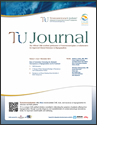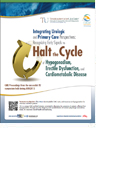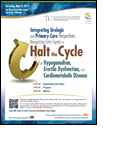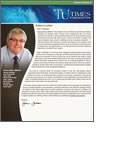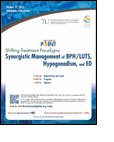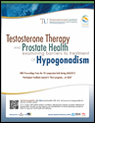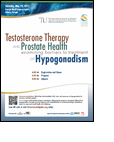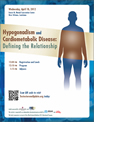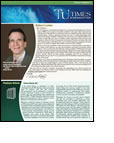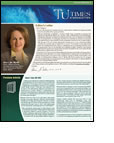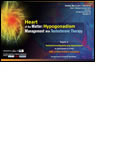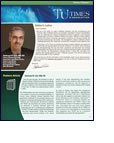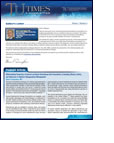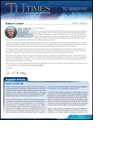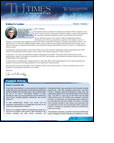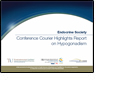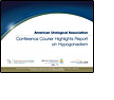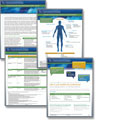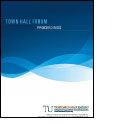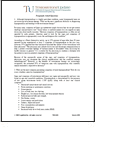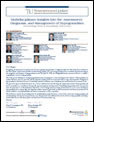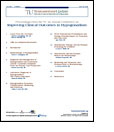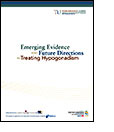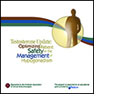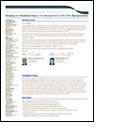Education
TU Journal
Martin M. Miner, MD, and Culley C. Carson III, MD, examine the association of metabolic syndrome, ED, hypogonadism and LUTS, and discuss how to optimize the management and treatment of these comorbid conditions. This educational activity is eligible for a maximum of 1.0 AMA PRA Category 1 Credit(s)™ through February 28, 2015.
Martin M. Miner, MD, and Culley C. Carson III, MD, examine the association of metabolic syndrome, ED, hypogonadism and LUTS, and discuss how to optimize the management and treatment of these comorbid conditions. This educational activity is eligible for a maximum of 1.0 AMA PRA Category 1 Credit(s)™ through February 28, 2015.
Doctor Is In—Case Study 7
Tom, a 65-year-old male patient initially presents with concerns about hypertension. Patient-centered interviewing reveals Tom's other medical concerns. Patient history, lab results, and office notes are followed by multiple-choice questions to elicit the diagnoses and treatment plans. Louis Kuritzky, MD is faculty. This educational activity is eligible for a maximum of 0.5 AMA PRA Category 1 Credit(s)™ through January 31, 2014.
Tom, a 65-year-old male patient initially presents with concerns about hypertension. Patient-centered interviewing reveals Tom's other medical concerns. Patient history, lab results, and office notes are followed by multiple-choice questions to elicit the diagnoses and treatment plans. Louis Kuritzky, MD is faculty. This educational activity is eligible for a maximum of 0.5 AMA PRA Category 1 Credit(s)™ through January 31, 2014.
AUA Monograph
Culley C. Carson III, MD, examines strategies to improve adherence and satisfaction with PDE5 inhibitor therapy and testosterone therapy and discusses the concomitant management of ED, BPH/LUTS, CVD, and hypogonadism to define how the management of these conditions may improve cardiometabolic parameters and overall cardiovascular health. This educational activity is eligible for a maximum of 1.5 AMA PRA Category 1 Credit(s)™ through January 31, 2015.
Culley C. Carson III, MD, examines strategies to improve adherence and satisfaction with PDE5 inhibitor therapy and testosterone therapy and discusses the concomitant management of ED, BPH/LUTS, CVD, and hypogonadism to define how the management of these conditions may improve cardiometabolic parameters and overall cardiovascular health. This educational activity is eligible for a maximum of 1.5 AMA PRA Category 1 Credit(s)™ through January 31, 2015.
Clinical Consult
Abraham Morgentaler, MD, examines a study reported by Vigen et al in The Journal of the American Medical Association, that assessed rates of death, myocardial infaction (MI), and stroke in men who received testosterone therapy for hypogonadism, and discusses the results of this study in the context of the existing literature about testosterone and cardiovascular risk. This educational activity is eligible for a maximum of 0.5 AMA PRA Category 1 Credit(s)™ through January 10, 2015.
Abraham Morgentaler, MD, examines a study reported by Vigen et al in The Journal of the American Medical Association, that assessed rates of death, myocardial infaction (MI), and stroke in men who received testosterone therapy for hypogonadism, and discusses the results of this study in the context of the existing literature about testosterone and cardiovascular risk. This educational activity is eligible for a maximum of 0.5 AMA PRA Category 1 Credit(s)™ through January 10, 2015.
Doctor Is In—Case Study 6
Participate in the Doctor Is In case studies, Evelyn, a 61-year-old female patient reports she is suffering from "significant fatigue and BPH/LUTS." Patient histories, lab results, and office notes are followed by multiple-choice questions to elicit the diagnoses and treatment plans. Sharon Parish, MD is faculty. This educational activity is eligible for a maximum of 0.5 AMA PRA Category 1 Credit(s)™ through September 30, 2014.
Participate in the Doctor Is In case studies, Evelyn, a 61-year-old female patient reports she is suffering from "significant fatigue and BPH/LUTS." Patient histories, lab results, and office notes are followed by multiple-choice questions to elicit the diagnoses and treatment plans. Sharon Parish, MD is faculty. This educational activity is eligible for a maximum of 0.5 AMA PRA Category 1 Credit(s)™ through September 30, 2014.
Clinical Consult
Allen D. Seftel, MD, discusses the importance of the Princeton III recommendations and implications of new evidence in evaluating the relationships of hypogonadism and ED with CVD. This educational activity is eligible for a maximum of 0.5 AMA PRA Category 1 Credit(s)™ through June 30, 2014.
Allen D. Seftel, MD, discusses the importance of the Princeton III recommendations and implications of new evidence in evaluating the relationships of hypogonadism and ED with CVD. This educational activity is eligible for a maximum of 0.5 AMA PRA Category 1 Credit(s)™ through June 30, 2014.
Case Report Podcast
Mohit Khera, MD, MBA, MPH, reviews a challenging case from his clinical practice involving a veteran being treated for chronic pain. Discussion includes history, diagnosis, management, treatment, and follow-up. This educational activity is eligible for a maximum of 0.25 AMA PRA Category 1 Credit(s)™ through May 31, 2014.
Mohit Khera, MD, MBA, MPH, reviews a challenging case from his clinical practice involving a veteran being treated for chronic pain. Discussion includes history, diagnosis, management, treatment, and follow-up. This educational activity is eligible for a maximum of 0.25 AMA PRA Category 1 Credit(s)™ through May 31, 2014.
Case Report Podcast
Edward D. Kim, MD, reviews a patient case from his clinical practice, addressing how to incorporate the application of topical testosterone into a daily hygiene routine. Discussion includes history, diagnosis, management, treatment, and follow-up. This educational activity is eligible for a maximum of 0.25 AMA PRA Category 1 Credit(s)™ through April 30, 2014.
Edward D. Kim, MD, reviews a patient case from his clinical practice, addressing how to incorporate the application of topical testosterone into a daily hygiene routine. Discussion includes history, diagnosis, management, treatment, and follow-up. This educational activity is eligible for a maximum of 0.25 AMA PRA Category 1 Credit(s)™ through April 30, 2014.
Case Report Podcast
Allen D. Seftel, MD, describes a challenging case from his practice, focusing on differences between testosterone formulations for a patient with adherence concerns. Discussion includes history, diagnosis, management, treatment, and follow-up. This educational activity is eligible for a maximum of 0.25 AMA PRA Category 1 Credit(s)™ through March 31, 2014.
Allen D. Seftel, MD, describes a challenging case from his practice, focusing on differences between testosterone formulations for a patient with adherence concerns. Discussion includes history, diagnosis, management, treatment, and follow-up. This educational activity is eligible for a maximum of 0.25 AMA PRA Category 1 Credit(s)™ through March 31, 2014.
Symposium at AUA
Attend Integrating Urologic and Primary Care Perspectives: Recognizing Early Signals to Halt the Cycle of Hypogonadism, Erectile Dysfunction, and Cardiometabolic Disease, a free CME-certified dinner symposium to be held May 4, 2013, at the San Diego Convention Center in conjunction with AUA2013. Faculty Jennifer R. Berman, MD; Culley C. Carson III, MD; and Martin M. Miner, MD, will examine strategies to improve adherence and satisfaction with PDE5 inhibitor therapy and testosterone therapy and focus on the concomitant management of ED, BPH/LUTS, CVD, and hypogonadism to define how the management of these conditions may improve cardiometabolic parameters and overall cardiovascular health.
Attend Integrating Urologic and Primary Care Perspectives: Recognizing Early Signals to Halt the Cycle of Hypogonadism, Erectile Dysfunction, and Cardiometabolic Disease, a free CME-certified dinner symposium to be held May 4, 2013, at the San Diego Convention Center in conjunction with AUA2013. Faculty Jennifer R. Berman, MD; Culley C. Carson III, MD; and Martin M. Miner, MD, will examine strategies to improve adherence and satisfaction with PDE5 inhibitor therapy and testosterone therapy and focus on the concomitant management of ED, BPH/LUTS, CVD, and hypogonadism to define how the management of these conditions may improve cardiometabolic parameters and overall cardiovascular health.
Breaking News
Experts respond to interview questions on managing men's health in this interactive video clinical opinion series featuring TU Distinguished Faculty Abraham Morgentaler, MD (Chairperson), and Adrian S. Dobs, MD, MHS. This educational activity is eligible for a maximum of 1.5 AMA PRA Category 1 Credit(s)™ through December 28, 2013.
Experts respond to interview questions on managing men's health in this interactive video clinical opinion series featuring TU Distinguished Faculty Abraham Morgentaler, MD (Chairperson), and Adrian S. Dobs, MD, MHS. This educational activity is eligible for a maximum of 1.5 AMA PRA Category 1 Credit(s)™ through December 28, 2013.
Newsletter
Graham Jackson, MB(Hons), and Wayne J.G. Hellstrom, MD, discuss the need for clinicians to educate patients about appropriate and inappropriate sources of health information and medications, particularly testosterone. This educational activity is eligible for a maximum of 1.0 AMA PRA Category 1 Credit(s)™ through December 28, 2013.
Graham Jackson, MB(Hons), and Wayne J.G. Hellstrom, MD, discuss the need for clinicians to educate patients about appropriate and inappropriate sources of health information and medications, particularly testosterone. This educational activity is eligible for a maximum of 1.0 AMA PRA Category 1 Credit(s)™ through December 28, 2013.
Symposium at AAFP
View the video presentations of Case in Point—Shifting Treatment Paradigms: Synergistic Management of BPH/LUTS, Hypogonadism, and ED, the TU symposium held in conjunction with the 2012 American Academy of Family Physicians Scientific Assembly. Culley C. Carson III, MD, served as Chairperson, with faculty Kevin T. McVary, MD, and Martin M. Miner, MD. This educational activity is approved by the AAFP for up to 1.25 Prescribed credit(s) and is eligible for a maximum of 1.25 AMA PRA Category 1 Credit(s)™ through December 17, 2013.
View the video presentations of Case in Point—Shifting Treatment Paradigms: Synergistic Management of BPH/LUTS, Hypogonadism, and ED, the TU symposium held in conjunction with the 2012 American Academy of Family Physicians Scientific Assembly. Culley C. Carson III, MD, served as Chairperson, with faculty Kevin T. McVary, MD, and Martin M. Miner, MD. This educational activity is approved by the AAFP for up to 1.25 Prescribed credit(s) and is eligible for a maximum of 1.25 AMA PRA Category 1 Credit(s)™ through December 17, 2013.
Breaking News
Experts respond to interview questions on managing men's health in this interactive video clinical opinion series featuring TU Distinguished Faculty Culley C. Carson III, MD (Chairperson); Kevin T. McVary, MD; and Martin M. Miner, MD. This educational activity is eligible for a maximum of 1.5 AMA PRA Category 1 Credit(s)™ through November 30, 2013.
Experts respond to interview questions on managing men's health in this interactive video clinical opinion series featuring TU Distinguished Faculty Culley C. Carson III, MD (Chairperson); Kevin T. McVary, MD; and Martin M. Miner, MD. This educational activity is eligible for a maximum of 1.5 AMA PRA Category 1 Credit(s)™ through November 30, 2013.
Doctor Is In—Parts 1-5
Participate in the Doctor Is In case studies, which follow patients with hypogonadism over the course of their office visits. Patient histories, lab results, and office notes are followed by multiple-choice questions to elicit the diagnoses and treatment plans. Faculty are Graham Jackson, MB(Hons); T. Hugh Jones, MD, MB, ChB, BSc; and Martin M. Miner, MD. This educational activity is eligible for a maximum of 2.5 AMA PRA Category 1 Credit(s)™ through September 30, 2013. (Parts 1-4 expire sooner; see CME Information.)
Participate in the Doctor Is In case studies, which follow patients with hypogonadism over the course of their office visits. Patient histories, lab results, and office notes are followed by multiple-choice questions to elicit the diagnoses and treatment plans. Faculty are Graham Jackson, MB(Hons); T. Hugh Jones, MD, MB, ChB, BSc; and Martin M. Miner, MD. This educational activity is eligible for a maximum of 2.5 AMA PRA Category 1 Credit(s)™ through September 30, 2013. (Parts 1-4 expire sooner; see CME Information.)
Symposium at AUA
Read the proceedings of the TU symposium Testosterone Therapy and Prostate Health: Examining Barriers to Treatment of Hypogonadism, held during AUA2012. Participant feedback named it "Best program… at AUA." Culley C. Carson III, MD, served as Chairperson, with faculty Mohit Khera, MD, MBA, MPH; Abraham Morgentaler, MD; and Jacob Rajfer, MD. This educational activity is eligible for a maximum of 1.5 AMA PRA Category 1 Credit(s)™ through August 31, 2013.
Read the proceedings of the TU symposium Testosterone Therapy and Prostate Health: Examining Barriers to Treatment of Hypogonadism, held during AUA2012. Participant feedback named it "Best program… at AUA." Culley C. Carson III, MD, served as Chairperson, with faculty Mohit Khera, MD, MBA, MPH; Abraham Morgentaler, MD; and Jacob Rajfer, MD. This educational activity is eligible for a maximum of 1.5 AMA PRA Category 1 Credit(s)™ through August 31, 2013.
Doctor on Call Podcast
Culley C. Carson III, MD; Kevin T. McVary, MD; and Martin M. Miner, MD, have a conversation about their clinical experience with and the latest evidence on the diagnosis and management of hypogonadism. This educational activity is eligible for a maximum of 0.5 AMA PRA Category 1 Credit(s)™ through August 31, 2013.
Culley C. Carson III, MD; Kevin T. McVary, MD; and Martin M. Miner, MD, have a conversation about their clinical experience with and the latest evidence on the diagnosis and management of hypogonadism. This educational activity is eligible for a maximum of 0.5 AMA PRA Category 1 Credit(s)™ through August 31, 2013.
Slide Library
Access comprehensive slide sets on hypogonadism, including sets for specialties, updated with emerging clinical data and innovative therapies, for healthcare professionals creating presentations. Download more than 200 slides FOR FREE.
Access comprehensive slide sets on hypogonadism, including sets for specialties, updated with emerging clinical data and innovative therapies, for healthcare professionals creating presentations. Download more than 200 slides FOR FREE.
Program Guide
Testosterone Therapy and Prostate Health: Examining Barriers to Treatment of Hypogonadism
Access the program guide from the CME-certified symposium held in conjunction with the American Urological Association's 2012 Annual Meeting. The faculty are Culley C. Carson III, MD (Chairperson); Mohit Khera, MD, MBA, MPH; Abraham Morgentaler, MD; and Jacob Rajfer, MD.
Testosterone Therapy and Prostate Health: Examining Barriers to Treatment of Hypogonadism
Access the program guide from the CME-certified symposium held in conjunction with the American Urological Association's 2012 Annual Meeting. The faculty are Culley C. Carson III, MD (Chairperson); Mohit Khera, MD, MBA, MPH; Abraham Morgentaler, MD; and Jacob Rajfer, MD.
View Presentations
Hypogonadism and Cardiometabolic Disease: Defining the Relationship
View presentations from the CME-certified symposium exploring the relationship between hypogonadism and cardiovascular disease held in conjunction with the American College of Physicians annual meeting, Internal Medicine 2012. Wayne J.G. Hellstrom, MD, serves as Chairperson, and the faculty are Adrian S. Dobs, MD, MHS, and Martin M. Miner, MD.
Hypogonadism and Cardiometabolic Disease: Defining the Relationship
View presentations from the CME-certified symposium exploring the relationship between hypogonadism and cardiovascular disease held in conjunction with the American College of Physicians annual meeting, Internal Medicine 2012. Wayne J.G. Hellstrom, MD, serves as Chairperson, and the faculty are Adrian S. Dobs, MD, MHS, and Martin M. Miner, MD.
Newsletter
Richard Sadovsky, MD, and Ajay Nehra, MD, discuss managing hypogonadism in patients who are HIV positive. Although this activity is no longer eligible for CME credit, it remains available on this website as an educational resource.
Richard Sadovsky, MD, and Ajay Nehra, MD, discuss managing hypogonadism in patients who are HIV positive. Although this activity is no longer eligible for CME credit, it remains available on this website as an educational resource.
KOL Video Debate
Four multidisciplinary key opinion leaders debate cutting-edge issues in 6 videos, each highlighting a different aspect of hypogonadism management. Martin M. Miner, MD (primary care), serves as Chairperson, and the faculty are Adrian S. Dobs, MD, MHS (endocrinology); Robert A. Kloner, MD, PhD (cardiology); and Abraham Morgentaler, MD (urology). Although this activity is no longer eligible for CME credit, it remains available on this website as an educational resource.
Four multidisciplinary key opinion leaders debate cutting-edge issues in 6 videos, each highlighting a different aspect of hypogonadism management. Martin M. Miner, MD (primary care), serves as Chairperson, and the faculty are Adrian S. Dobs, MD, MHS (endocrinology); Robert A. Kloner, MD, PhD (cardiology); and Abraham Morgentaler, MD (urology). Although this activity is no longer eligible for CME credit, it remains available on this website as an educational resource.
Newsletter
Adrian S. Dobs, MD, MHS, and John E. Morley, MB, BCh, discuss the relationship between hypogonadism and osteoporosis. Although this activity is no longer eligible for CME credit, it remains available on this website as an educational resource.
Adrian S. Dobs, MD, MHS, and John E. Morley, MB, BCh, discuss the relationship between hypogonadism and osteoporosis. Although this activity is no longer eligible for CME credit, it remains available on this website as an educational resource.
Case Study
This 3-part case study follows a patient over the course of 9 months of office visits. A patient history, lab results, and office notes are followed by multiple-choice questions to elicit the diagnosis and treatment plan. The faculty are Robert A. Feldman, MD, and Joel M. Kaufman, MD. Although this activity is no longer eligible for CME credit, it remains available on this website as an educational resource.
This 3-part case study follows a patient over the course of 9 months of office visits. A patient history, lab results, and office notes are followed by multiple-choice questions to elicit the diagnosis and treatment plan. The faculty are Robert A. Feldman, MD, and Joel M. Kaufman, MD. Although this activity is no longer eligible for CME credit, it remains available on this website as an educational resource.
ENDO Conference Courier Report
The impact of hypogonadism on men's overall health and well-being was one of the state-of-the-art topics at the Endocrine Society's 93rd Annual Meeting and Expo. The faculty are Adrian S. Dobs, MD, MHS, and Christina Wang, MD. Although this activity is no longer eligible for CME credit, it remains available on this website as an educational resource.
The impact of hypogonadism on men's overall health and well-being was one of the state-of-the-art topics at the Endocrine Society's 93rd Annual Meeting and Expo. The faculty are Adrian S. Dobs, MD, MHS, and Christina Wang, MD. Although this activity is no longer eligible for CME credit, it remains available on this website as an educational resource.
AUA Conference Courier Report
Hypogonadism and its impact on men's health was one of the state-of-the-art topics at the 2011 annual meeting of the American Urological Association. Martin M. Miner, MD, and Ajay Nehra, MD, are faculty. Although this activity is no longer eligible for CME credit, it remains available on this website as an educational resource.
Hypogonadism and its impact on men's health was one of the state-of-the-art topics at the 2011 annual meeting of the American Urological Association. Martin M. Miner, MD, and Ajay Nehra, MD, are faculty. Although this activity is no longer eligible for CME credit, it remains available on this website as an educational resource.
Access Materials
Heart of the Matter: Hypogonadism Management With Testosterone Therapy
Access materials presented at the multisponsored CME-certified symposium exploring the relationship between testosterone and cardiovascular disease held in conjunction with the AUA 2011 Annual Meeting. Allen D. Seftel, MD (Chairperson); Adrian S. Dobs, MD, MHS; Robert A. Kloner, MD, PhD; and Martin M. Miner, MD, provided multidisciplinary perspectives on current debates regarding screening, diagnosis, and therapeutic options for hypogonadism.
Heart of the Matter: Hypogonadism Management With Testosterone Therapy
Access materials presented at the multisponsored CME-certified symposium exploring the relationship between testosterone and cardiovascular disease held in conjunction with the AUA 2011 Annual Meeting. Allen D. Seftel, MD (Chairperson); Adrian S. Dobs, MD, MHS; Robert A. Kloner, MD, PhD; and Martin M. Miner, MD, provided multidisciplinary perspectives on current debates regarding screening, diagnosis, and therapeutic options for hypogonadism.
Newsletter
Abdulmaged M. Traish, MBA, PhD, and Andre T. Guay, MD, examine the interrelationship of type 2 diabetes, insulin resistance, and hypogonadism, discuss the pathophysiologic link, and offer treatment strategies. Although this activity is no longer eligible for CME credit, it remains available on this website as an educational resource.
Abdulmaged M. Traish, MBA, PhD, and Andre T. Guay, MD, examine the interrelationship of type 2 diabetes, insulin resistance, and hypogonadism, discuss the pathophysiologic link, and offer treatment strategies. Although this activity is no longer eligible for CME credit, it remains available on this website as an educational resource.
Newsletter
Glenn R. Cunningham, MD, and Robert S. Tan, MD, MBA, survey the range of testosterone formulations, focusing on the gels currently available and those in development, and offer clinical tips for optimizing safety, efficacy, and adherence. Although this activity is no longer eligible for CME credit, it remains available on this website as an educational resource.
Glenn R. Cunningham, MD, and Robert S. Tan, MD, MBA, survey the range of testosterone formulations, focusing on the gels currently available and those in development, and offer clinical tips for optimizing safety, efficacy, and adherence. Although this activity is no longer eligible for CME credit, it remains available on this website as an educational resource.
Newsletter
Ronald S. Swerdloff, MD, and Wayne J.G. Hellstrom, MD, respond to public confusion of anabolic-androgenic steroid abuse and testosterone therapy. Although this activity is no longer eligible for CME credit, it remains available on this website as an educational resource.
Ronald S. Swerdloff, MD, and Wayne J.G. Hellstrom, MD, respond to public confusion of anabolic-androgenic steroid abuse and testosterone therapy. Although this activity is no longer eligible for CME credit, it remains available on this website as an educational resource.
Case Study
This 3-part case study follows a patient over the course of 9 months of office visits. A patient history, lab results, and office notes are followed by multiple-choice questions to elicit the diagnosis and treatment plan. Although this activity is no longer eligible for CME credit, it remains available on this website as an educational resource.
This 3-part case study follows a patient over the course of 9 months of office visits. A patient history, lab results, and office notes are followed by multiple-choice questions to elicit the diagnosis and treatment plan. Although this activity is no longer eligible for CME credit, it remains available on this website as an educational resource.
Newsletter
Ronald S. Swerdloff, MD, and Adrian S. Dobs, MD, MHS, evaluate the research exploring the association between testosterone and cardiovascular disease. Although this activity is no longer eligible for CME credit, it remains available on this website as an educational resource.
Ronald S. Swerdloff, MD, and Adrian S. Dobs, MD, MHS, evaluate the research exploring the association between testosterone and cardiovascular disease. Although this activity is no longer eligible for CME credit, it remains available on this website as an educational resource.
ENDO Conference Courier Highlights
The treatment of hypogonadism was one of the state-of-the-art topics at the 2010 annual meeting of the Endocrine Society.
The treatment of hypogonadism was one of the state-of-the-art topics at the 2010 annual meeting of the Endocrine Society.
AUA Conference Courier Highlights
Hypogonadism and its impact on men's health was one of the state-of-the-art topics at the 2010 annual meeting of the American Urological Association.
Hypogonadism and its impact on men's health was one of the state-of-the-art topics at the 2010 annual meeting of the American Urological Association.
Downloadable TU Toolkit
Four clinical tools support hypogonadism diagnosis, management, and patient care, including tips on raising patient awareness about hypogonadism.
Four clinical tools support hypogonadism diagnosis, management, and patient care, including tips on raising patient awareness about hypogonadism.
Town Hall Forum Proceedings
TestosteroneUpdate Distinguished Faculty convened to discuss cutting-edge information concerning the diagnosis and treatment of hypogonadism, with the goal of increasing awareness about this underrecognized and undertreated condition. Although this activity is no longer eligible for CME credit, it remains available on this website as an educational resource.
TestosteroneUpdate Distinguished Faculty convened to discuss cutting-edge information concerning the diagnosis and treatment of hypogonadism, with the goal of increasing awareness about this underrecognized and undertreated condition. Although this activity is no longer eligible for CME credit, it remains available on this website as an educational resource.
Highlights Report
American Urological Association Conference Courier Highlights Report on Hypogonadism
The treatment of hypogonadism was one of the state-of-the-art topics at the 2009 annual meeting of the American Urological Association.
American Urological Association Conference Courier Highlights Report on Hypogonadism
The treatment of hypogonadism was one of the state-of-the-art topics at the 2009 annual meeting of the American Urological Association.
Highlights Report
Endocrine Society Conference Courier Highlights Report on Hypogonadism
The treatment of hypogonadism was one of the state-of-the-art topics at the 2009 annual meeting of the Endocrine Society.
Endocrine Society Conference Courier Highlights Report on Hypogonadism
The treatment of hypogonadism was one of the state-of-the-art topics at the 2009 annual meeting of the Endocrine Society.
Frequently Asked Questions
This downloadable reference guide answers commonly asked questions about the diagnosis, management, and treatment of hypogonadism. Topics include comorbidities, efficacy and safety of testosterone therapy, and tips for optimizing long-term persistence with testosterone therapy and treatment success.
This downloadable reference guide answers commonly asked questions about the diagnosis, management, and treatment of hypogonadism. Topics include comorbidities, efficacy and safety of testosterone therapy, and tips for optimizing long-term persistence with testosterone therapy and treatment success.
Highlights From Disease State Theater
Experts from the fields of endocrinology, primary care, and urology presented at the 2008 American Urological Association and Endocrine Society annual meetings on treatment of hypogonadism in men. The proceedings from these meetings review the current data on hypogonadism and offer recommendations that can be incorporated into your clinical practice.
Experts from the fields of endocrinology, primary care, and urology presented at the 2008 American Urological Association and Endocrine Society annual meetings on treatment of hypogonadism in men. The proceedings from these meetings review the current data on hypogonadism and offer recommendations that can be incorporated into your clinical practice.
Disease State Theater Podcast
View the presentations from the 2008 annual meetings of the American Urological Association and the Endocrine Society.
View the presentations from the 2008 annual meetings of the American Urological Association and the Endocrine Society.
Roundtable Discussion
Multidisciplinary Insights Into the Assessment, Diagnosis, and Management of Hypogonadism
Experts from the fields of endocrinology, primary care, and urology participated in a roundtable discussion focusing on the diagnosis and treatment of hypogonadism in men.
Multidisciplinary Insights Into the Assessment, Diagnosis, and Management of Hypogonadism
Experts from the fields of endocrinology, primary care, and urology participated in a roundtable discussion focusing on the diagnosis and treatment of hypogonadism in men.
Proceedings
Proceedings From the TU 1st Annual Conference on Improving Clinical Outcomes in Hypogonadism
Physicians at the forefront of treatment and research presented and discussed treatment considerations in the management of hypogonadism.
Proceedings From the TU 1st Annual Conference on Improving Clinical Outcomes in Hypogonadism
Physicians at the forefront of treatment and research presented and discussed treatment considerations in the management of hypogonadism.
Monograph
Emerging Evidence and Future Directions in Treating Hypogonadism
Four to five million American men are affected by hypogonadism. There are several challenges concerning hypogonadism, from the clinical diagnosis to the safety of testosterone therapy. It is important for clinicians to have an understanding of male hypogonadism and how to apply clinical guidelines in their practice to improve patient outcomes. This monograph examines issues facing physicians who manage patients with hypogonadism, offering information to help make informed treatment decisions. Co-authors are Adrian S. Dobs, MD, MHS, and Frances J. Hayes, MD.
Emerging Evidence and Future Directions in Treating Hypogonadism
Four to five million American men are affected by hypogonadism. There are several challenges concerning hypogonadism, from the clinical diagnosis to the safety of testosterone therapy. It is important for clinicians to have an understanding of male hypogonadism and how to apply clinical guidelines in their practice to improve patient outcomes. This monograph examines issues facing physicians who manage patients with hypogonadism, offering information to help make informed treatment decisions. Co-authors are Adrian S. Dobs, MD, MHS, and Frances J. Hayes, MD.
Symposium
Optimizing Patient Safety in the Management of Hypogonadism
This satellite symposium was presented at the 16th Annual Meeting and Clinical Congress of the American Association of Clinical Endocrinologists.
Optimizing Patient Safety in the Management of Hypogonadism
This satellite symposium was presented at the 16th Annual Meeting and Clinical Congress of the American Association of Clinical Endocrinologists.
Clinical Statement Paper
Bridging the Treatment Gaps in the Management of Hypogonadism At their 2007 meeting, TU Distinguished Faculty addressed issues facing clinicians who treat men with hypogonadism. Where evidence was lacking, they offered considerations to help clinicians make informed treatment decisions. This clinical statement paper was developed based on the discussions and interaction at this meeting.
Bridging the Treatment Gaps in the Management of Hypogonadism At their 2007 meeting, TU Distinguished Faculty addressed issues facing clinicians who treat men with hypogonadism. Where evidence was lacking, they offered considerations to help clinicians make informed treatment decisions. This clinical statement paper was developed based on the discussions and interaction at this meeting.

